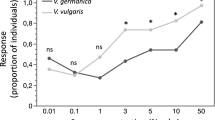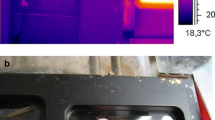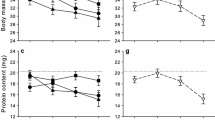Abstract
The classic formulation of optimal foraging theory predicts that a central-place forager will gather more food if it is required to travel farther from the nest to find that food. We examined the foraging behavior of German yellowjackets (Vespula germanica) to determine whether carbohydrate foragers follow this pattern. We trained foragers to collect 2 M fructose solution at 5 or 50 m from the nest and measured the time spent feeding, load size, and the rate of delivery. We show that as a forager’s crop fills during a foraging bout, the amount of solution ingested per second decreased. However, load size did not change as wasps collected food up to 50 m from the nest. Instead, temperature and body size were better predictors of the volume of fructose a forager carried. Finally, the rate of fructose delivered to the nest was higher at warmer temperatures. Due to the fact that wasps gather more food but feed for shorter periods of time at warmer temperatures, we found an overall negative relationship between feeding time and load size. We conclude that the strong effects temperature had on the behavior of V. germanica foragers imply that feeding time may not always be an accurate predictor of the size of the load an individual carries back to the nest. Results from this study suggest that in yellowjacket colonies, foragers can collect and bring disproportionately more food back to the nest during the warmest days of the summer, a time of year when this pest species reaches peak population size during its annual colony cycle.





Similar content being viewed by others
References
Afik O. and Shafir S. 2007. Effect of ambient temperature on crop loading in the honey bee, Apis mellifera (Hymenoptera: Apidae). Entomol. Gener. 29: 135-148
Akre R.D., Garnett W.B., MacDonald J.F., Greene A. and Landolt P. 1976. Behavior and colony development of Vespula pensylvanica and V. atropilosa (Hymenoptera: Vespidae). J. Kansas Entomol. Soc. 49: 63-84
Archer M.E. 1998. A lifetime with wasps (Hymenoptera: Vespinae). Naturalist 123: 3-13
Bonser R., Wright P.J., Bament S. and Chukwu U.O. 1998. Optimal patch use by foraging workers of Lasius fuliginosus, L. niger and Myrmica ruginodis. Ecol. Entomol. 23: 15-21
Bräuninger H.D. 1964. Über den Einfluß meteorologischer Faktoren auf die Entfernungsweisung im Tanz der Bienen. Z. vergl. Physiol. 48: 1-30
Burd M., Archer D., Aranwela N. and Stradling D.J. 2002. Traffic dynamics of the leaf-cutting ant, Atta cephalotes. Amer. Nat. 159: 283-293
Crist T.O. and MacMahon J.A. 1991. Individual foraging components of harvester ants: movement patterns and seed patch fidelity. Insect. Soc. 38: 379-396
D’Adamo P. and Lozada M. 2007. Foraging behavior related to habitat characteristics in the invasive wasp Vespula germanica. Insect Sci. 14: 383-388
D’Adamo P. and Lozada M. and Corley J.C. 2004. An attraction pheromone from heads of worker Vespula germanica wasps. J. Insect Behav. 17: 809-821
Farji-Brener A.G. 2000. Leaf-cutting ant nests in temperate environments: mounds, mound damages and nest mortality rate in Acromyrmex lobicornis. Studies Neotrop. Fauna Envir. 35: 131-138
Ferster B. and Traniello J.F.A. 1995. Polymorphism and foraging behavior in Pogonomyrmex badius (Hymenoptera: Formicidae): Worker size, foraging distance, and load size associations. Envir. Entomol. 24: 673-678
Frisch K. 1993. The Dance Language and Orientation of Bees. Cambridge, MA: Harvard University Press. 592 pp
Heinrich B. 2004. Bumblebee Economics. Cambridge, MA: Harvard University Press. 288 pp
Jandt J.M. and Jeanne R.L. 2005. German yellowjacket (Vespula germanica) foragers use odors inside the nest to find carbohydrate food sources. Ethology 111: 641-651
Jandt J.M., Riel L., Crain B. and Jeanne R.L. 2005. Vespula germanica foragers do not scent-mark carbohydrate food sites. J. Insect Behav. 18: 19-31
Kasuya E. 1982. Factors governing the evolution of eusociality through kin selection. Res. Pop. Ecol. 24: 174-192
Kingsolver J.G. 2000. Feeding, growth, and the thermal environment of cabbage white caterpillars, Pieris rapae L. Physiol. Biochem. Zool. 73: 621-628
Kingsolver J.G. and Woods H.A. 1997. Thermal sensitivity of growth and feeding in Manduca sexta caterpillars. Physiol. Zool. 70: 631-638
Krebs J.R. and Davies N.B. 1993. An Introduction to Behavioural Ecology. Oxford: Blackwell. 420 pp
Levesque K.R., Fortin M. and Mauffette Y. 2002. Temperature and food quality effects on growth, consumption and post-ingestive utilization efficiencies of the forest tent caterpillar Malacosoma disstria (Lepidoptera: Lasiocampidae). Bull. Entomol. Res. 92: 127-136
Macfarlane R.P. 1976. Fungi associated with Bombinae (Apidae: Hymenoptera) in North America. Mycopathologia 59: 41-42
Meats A. and Kelly G.L. 2008. Relation of constant, daily fluctuating, and ambient feeding temperature to daily and accumulated consumption of yeast autolysate and sucrose by female Queensland fruit fly. Entomol. Exper. Appl. 129: 87-95
Moreyra S., D’Adamo P. and Lozada M. 2006. Odour and visual cues utilised by German yellowjackets (Vespula germanica) while relocating protein or carbohydrate resources. Austral. J. Zool. 54: 393-397
Nuñez J.A. 1982. Honeybee foraging strategies at a food source in relation to its distance from the hive and the rate of sugar flow. J. Apicult. Res. 21: 139-150
Orians G.H. and Pearson N.E. 1979. On the theory of central place foraging. In: Analysis of Ecological Systems (Horn D.J., Stairs G.R. and Mitchell R.D., Eds), Columbus, OH: Ohio State University Press. pp 155-177
Roces F. 1990. Leaf-cutting ants cut fragment sizes in relation to the distance from the nest. Anim. Behav. 40: 1181-1183
Saravacos G.D. 1970. Effect of temperature on viscosity of fruit juices and purees. J. Food Sci. 35: 122-125
Stephens D.W. and Krebs J.R. 1986. Foraging Theory. Princeton, NJ: Princeton University Press. 262 pp
Stone G.N. 1993. Endothermy in the solitary bee Anthophora plumipes: Independent measures of thermoregulatory ability, costs of warm-up and the role of body size. J. Exper. Biol. 174: 299-320
Timms S.A. 1976. Medically important pests. In: New Zealand Insect Pests (Ferro D.N., Ed), Canterbury, NZ: Lincoln University College of Agriculture. pp 202-203
Traniello J.F.A., Fujita M.S. and Bowen R.V. 1984. Ant foraging behavior: ambient temperature influences prey selection. Behav. Ecol. Sociobiol. 15: 65-68
Wetterer J.K. 1990. Load-size determination in the leaf-cutting ant, Atta cephalotes. Behav. Ecol. 1: 95-101
Williams D. 2003. Infanticide: Historical perspectives on child murder and concealment, 1550-2000. Parergon 20: 236-239
Willott S.J., Compton S.G. and Incoll L.D. 2000. Foraging, food selection and worker size in the seed harvesting ant Messor bouvieri. Oecologia 125: 35-44
Wright P.J., Bonser R. and Chukwu U.O. 2000. The size–distance relationship in the wood ant Formica rufa. Ecol. Entomol. 25: 226-233
Ydenberg R.C. 2007. Provisioning. In: Foraging: Behavior and Ecology (Stephens D.W., Brown J.S. and Ydenberg R.C., Eds), Chicago, IL: The University of Chicago Press. pp 273-304
Acknowledgments
We are grateful to Jeff and Denise Baylis and to West Madison Agricultural Research Station for allowing us to work with yellowjackets on their properties. We thank Susan Dorst and Doug Thiessen for allowing us to excavate yellowjacket nests from their lawns, and Mark Allington for constructing nest boxes. For help in collecting and setting up nests, we thank Lucas Rifkin and Ken Howard. We also appreciate Lucas Rifkin’s assistance with collecting data. We are also grateful to Dave Stephens’s suggestions on rate of uptake analyses, and Goggy Davidowitz and his lab group for their help on preparing the manuscript. Research supported by Hatch grant no. 4433 to R.L.J. and by the College of Agricultural and Life Sciences, UW-Madison.
Author information
Authors and Affiliations
Corresponding author
Rights and permissions
About this article
Cite this article
Jandt, J.M., Taylor, B. & Jeanne, R.L. Temperature and forager body size affect carbohydrate collection in German yellowjackets, Vespula germanica (Hymenoptera, Vespidae). Insect. Soc. 57, 275–283 (2010). https://doi.org/10.1007/s00040-010-0082-5
Received:
Revised:
Accepted:
Published:
Issue Date:
DOI: https://doi.org/10.1007/s00040-010-0082-5




